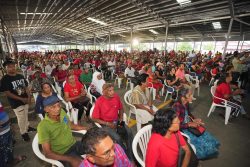Many of the shires (counties) in the UK have web portals which begin with the words ‘This is,’ and what they do is provide a wealth of information on the area. For instance, a visitor to Leicestershire would find on its ‘This is’ page, historical information, where to find what, news, links to jobs, real estate, pubs, almost everything anyone might need to know. Perhaps this may have caught on in other places in some other parts of the world. Not in Guyana, though. Here, ‘This is Guyana’ is a sentence that brings with it connotations of everything that could possibly be wrong.
For example, if one found oneself waiting at 10:00 hrs for a scheduled 09:00 hrs event to begin, the reason that would be given is that this is Guyana. It is used almost wholesale to explain practically every flawed eventuality: blackouts, corruption, nepotism, unsolved crimes, water shortages, injustice – the list can go on and on. But it’s a useless tally really, since no true Guyanese would like to see any of this on a web portal introducing Guyana to the rest of the world.
Just this last Monday, President Bharrat Jagdeo, as he launched what was called the third draft of Guyana’s Low Carbon Development Strategy, shed some light on the “Guyana way of doing things.” He intimated that though there had been no consensus in Copenhagen last December, Guyana was not prepared to turn away from playing a role in combatting climate change. He held out the hope that his imminent trip to Norway would bear fruit to the tune of millions of US$ to be spent over the next few years on climate change initiatives, one of which was the Amaila Falls hydropower project.
This hydroelectric project, which the President said would cost some US$450 million will, the ‘This is Guyana’ invocation notwithstanding, be ready for commercial operation by October 2014. Hardly believable it is, that Guyana will have commercial quantities of green energy in the next four years – all things being equal that is. One question that is yet to be completely and comprehensively answered is whether this hydropower will be available throughout the entire country.
In the meantime, while we await this progressive step we must continue to endure the blackouts and the high and low voltages still being supplied. We must still resign ourselves to using candles, flambeaux and kerosene lamps, especially the poor families who cannot afford the high electricity rates, or those who live in unelectrified communities, or the residents of Berbice, where periods of outage currently exceed periods of power supply.
Obviously, no one needs any alternative form of energy. Who cares if Food For The Poor in collaboration with the Roetheli family of the USA successfully built 100 houses in the Lil Red Village and supplied each one with solar power? What does it matter if smaller hydropower projects might be more feasible? After all, it’s just another four years then all will be well.
Meanwhile, we must unquestioningly swallow the drivel being fed to us by smarmy politicians; like the “one laptop computer per family” statement, dished out last week by Minister of Education Shaik Baksh, who said government is working out the modalities and costing for this initiative. Surely this cannot precede the completion of the great hydroelectric project. For while we are not all tech savvy, certainly everyone must know that laptops carry batteries which must be charged and that this cannot be done with candles, flambeaux or kerosene. And unless there are also plans to have Wi-Fi throughout the country, there will be need for other infrastructure to allow the laptops to access the World Wide Web. But why worry, this must have all been thought through. It just was not conveyed to the rest of us. After all, this is Guyana; this is the Guyana way of doing things.









